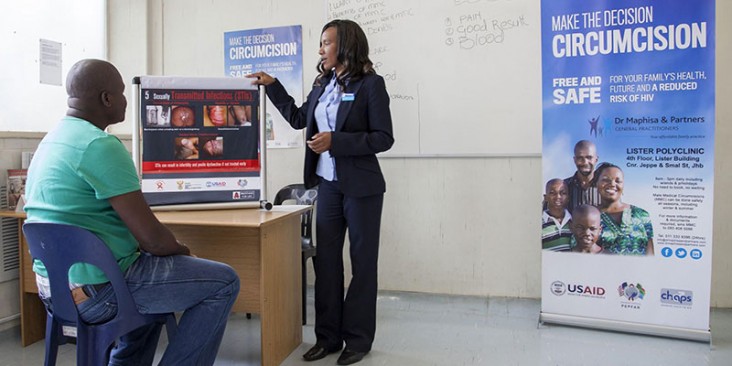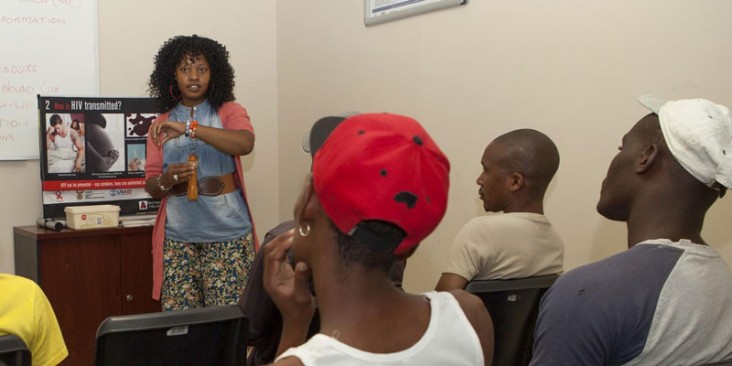- What We Do
- Agriculture and Food Security
- Democracy, Human Rights and Governance
- Economic Growth and Trade
- Education
- Ending Extreme Poverty
- Environment and Global Climate Change
- Gender Equality and Women's Empowerment
- Global Health
- Water and Sanitation
- Working in Crises and Conflict
- U.S. Global Development Lab

October 2016—The U.S. Agency for International Development (USAID) relies on careful data collection to create, implement and refine many of its HIV and AIDS programs, including its voluntary medical male circumcision (VMMC). Through innovative web-based tools, USAID has taken VMMC data collection a step further by introducing mathematical modeling. Mathematical modeling is a method that uses mathematical concepts to simulate real-life situations and forecast future behavior, helping to estimate indicators that might not be possible to measure directly, such as trends in HIV incidence or AIDS-related deaths. Harnessing data through this method has shown many positive effects in providing better VMMC services and service coverage. From supporting advocacy, to informing program planning and implementation, to tracking progress and impact, modeling has played – and continues to play – a critical role in shaping national and global policies on VMMC.
"Planning a country's response to HIV is a complex decision-making process that must take into account epidemiological impact, cost effectiveness, feasibility of delivery, among many other factors," said the Ministry of Health's Principal Secretary Dr. Simon Zwane during the launch of the Swaziland Male Circumcision Strategy and Operational Plan for HIV Prevention for 2014–2018. For Swaziland, mathematical modeling has proven to be a critical tool in tailoring the national VMMC program to maximize impact while maintaining programmatic feasibility.

Swaziland is not the only country implementing mathematical modeling to help optimize VMMC programming efforts. In 2007, in light of evidence that VMMC reduces HIV acquisition in men, UNAIDS and the World Health Organization (WHO) prioritized 13 countries in eastern and southern Africa for rapid scale-up to 80 percent male circumcision prevalence. Reaching this goal, however, would require a significant global advocacy effort to mobilize the considerable technical and financial resources needed from country governments and international donors.
To demonstrate the long-term benefits of VMMC scale-up, a team of modelers created the Decision Makers' Program Planning Tool (DMPPT), a Microsoft Excel-based tool that estimates the epidemiologic impact and cost-effectiveness associated with different VMMC scale-up scenarios. In 2011, the team populated the tool with publicly available data for each of the 13 priority countries. The results showed that VMMC scale-up to 80 percent male circumcision coverage among men ages 15–49 would result in both substantial reductions in HIV infections and in savings in treatment costs averted. After publishing those results and presenting them around the world, the UNAIDS-WHO Joint Strategic Action Framework to Accelerate the Scale-Up of Voluntary Medical Male Circumcision for HIV Prevention in Eastern and Southern Africa [PDF, 1.7MB] was launched in December 2011. Subsequently, the 13 countries included VMMC scale-up in their national strategic plans, and the U.S. President's Emergency Plan for AIDS Relief (PEPFAR) significantly increased its VMMC budget.
As roll-out of VMMC proceeded, new questions arose that could not be addressed with the DMPPT. In response, the modeling team from the USAID- and PEPFAR-funded Health Policy Project (HPP) created the DMPPT 2.0 [PDF, 272KB] to help program planners focus and prioritize their VMMC programs by client age group and subnational region. This time, instead of conducting a desk exercise, the team worked closely with country stakeholders to implement the DMPPT 2.0 in nine countries, customizing model inputs and analyses based on country stakeholder inputs led by the Ministries of Health (MOHs). The countries included: Kenya, Lesotho, Malawi, Namibia, Mozambique, South Africa, Swaziland, Tanzania and Uganda.
Following initial implementation of a national policy for male circumcision in 2008, the Swaziland MOH was interested in understanding the implications of focusing VMMC services on specific age groups and, more specifically, the varying demand among different age groups. An in-depth modeling application of the DMPPT 2.0 in 2013 and 2014 helped the MOH incorporate updated, evidence-based targets into the Male Circumcision Strategic and Operational Plan for HIV Prevention, 2014–2018. After examining the results of six modeling scenarios, the MOH chose the following scale-up plan: scaling up to 50 percent coverage for newborns, 80 percent among males ages 10–29 and 55 percent among males ages 30–34. This plan was chosen with the intention of balancing cost, cost-effectiveness, impact and programmatic feasibility.
Today, the DMPPT 2.0 is helping priority countries track progress toward their goals, allowing stakeholders to generate targets, assess impacts to date and disaggregate coverage estimates by age and district. A web-based system has been developed and will update these calculations annually for ongoing monitoring and program planning, ultimately making them widely available to country stakeholders in a user-friendly format. This information also has proven critical to countries transitioning from scaling up VMMC to maintaining coverage levels and will continue to inform national strategies moving forward.
DMPPT 2.0 was created under the USAID-funded Health Policy Project (HPP), which supported the first round of modeling applications in five countries: Malawi, South Africa, Swaziland, Tanzania and Uganda. The USAID-funded Project SOAR (Supporting Operational AIDS Research) supported application of the model in Kenya, Lesotho, Mozambique and Namibia, and it is also overseeing the conversion of the model into a web-based version.
Additional Links
- Read more about USAID's VMMC Programs
- Visit the USAID's Office of HIV/AIDS Website
- View the PLOS Collection: VMMC for HIV Prevention: New Mathematical Models for Prioritizing Sub-Populations by Age & Geography







Comment
Make a general inquiry or suggest an improvement.